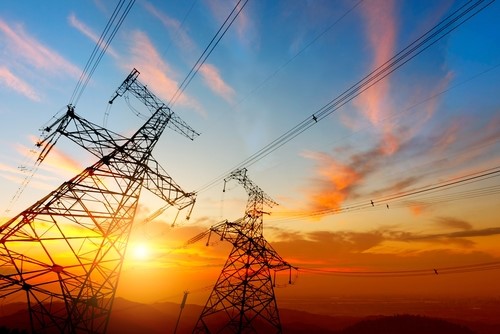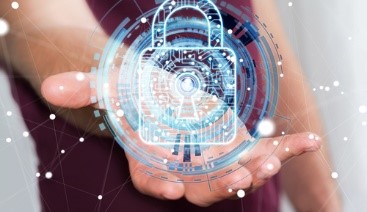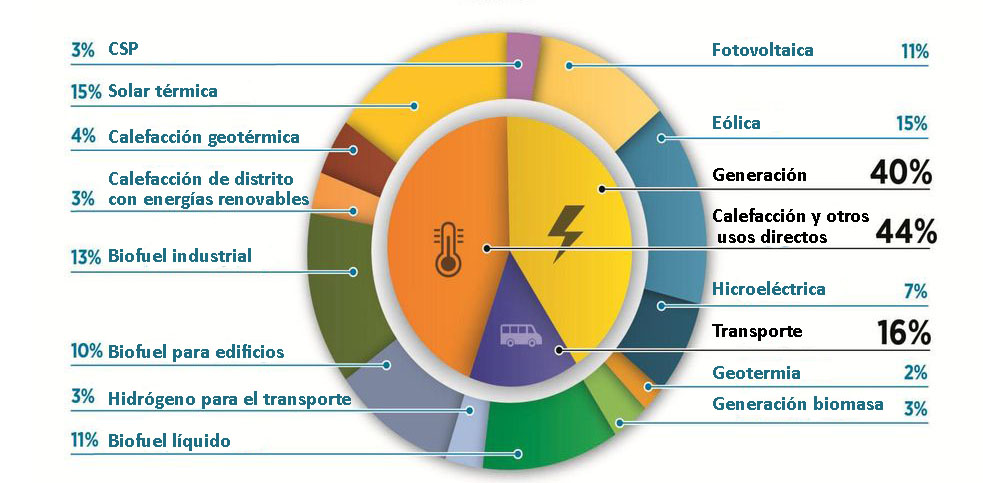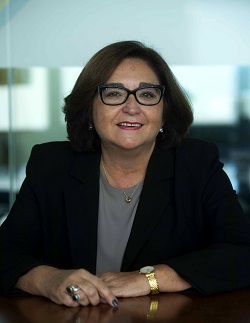Decarbonization commitments accepted globally by states and undertakings are resulting in an energy transition where fossil fuels are gradually being replaced by renewable energy. Society in general, with industry at the head, is facing a series of challenges where diversification in energy generation and the digitization of electricity grids will be playing a decisive role in the way energy is produced and consumed in the future.
We are aiming for a decarbonized model “in which greenhouse gas emissions caused by energy consumption needs to be steadily phased out,” maintains Marina Serrano, the Chair of the Electricity Suppliers Association (aelēc). In fact, that is the central aim of the Paris Agreement, a global pact for fighting against climate change, which came into force in 2016, under which its 197 signatory countries agreed to adopt sustainable measures for preventing a rise in the planet’s temperature by over 2°C by the end of this century “and to pursue efforts to limit the temperature increase even further to 1.5 degrees Celsius.”
The key to decarbonizing the economy depends, according to Serrano, on the electrification society as a whole. “Up until now, the energy sector that has so far proved itself capable of generating pollution-free energy is electricity,” argues the expert, for whom a mass influx of renewable energies will enable energy consumption without the emission of gases into the atmosphere.
Europe, leading in process
It is the European Union, more than any other institution, that has committed itself to leading this process of decarbonizing the planet, even though its levels of electrification over the total energy consumption are currently low – around 22%. Both the European Commission and the EU’s member States have spent years working on the development of plans enabling the fastest possible occurrence of this transition and at an affordable cost for consumers and undertakings.
“It is a global process where international electric interconnections also have a role to play in all this transformation”, highlights the Chair of aelēc. By way of example, she then points out the indispensable collaboration between the EU’s states for creating what is known as the Single European Energy Market, which requires common rules for all member states; integrated markets that act as one; and the necessary capacity for enabling energy exchanges wherever possible, using renewable energy surpluses between European and other zones so as to exploit production to the maximum.
That is the goal towards which the European Commission has been working, whereby it considers it crucial to eliminate energy-consumption emissions (which represent nearly 80% of the total) before the end of the first half of the century. The European Union has praised several projects created to that end, such as Spain’s Integrated National Energy and Climate Plan (PNIEC), suggested by the Spanish government, which proposes a 21% reduction in greenhouse gas emissions for 2030, compared to 1990.
The change in energy model will thus be a decades-long journey, moving away from a paradigm mainly involving an excessive exploitation of fossil fuels such as coal or petrol towards another where the electricity sector is a priority in our industries.
Progress in electrifying the economy based on renewable sources has been resulting in a steady increase in investments.
Towards an effective energy transition
Progress in electrifying the economy based on renewable sources is becoming an irreversible process worldwide, which is resulting in a steady increase in investments, while the health and environmental benefits of embarking on this process are substantial. Even so, additional investment needs associated with the transition for ensuring roughly 70% of the global energy-supply mix in 2050 is low in carbon (as required for compliance with the Paris Agreement) would not exceed 0.4% of the world GNP according to the International Renewable Energy Agency (IRENA), with a positive net impact on employment and economic growth.
Fortunately, the transition process has already overcome two key obstacles: the technology for making this change at an affordable cost is now widely available throughout the world (mainly for photovoltaic-solar and wind energies); and the international commitment to make this transition is sound, especially in the European Union.
This is why Serrano notes that the main challenge at present involves the visibility that players have for being able to invest in these processes. Prior knowledge is required of the conditions that are offered to players for committing to such renewable technologies and in electricity grids, with the latter being especially critical. There is likewise a requirement for a stable and predictable regulatory framework that sends the right signals so that undertakings can know when they have to fund these projects. “We mustn’t forget that investments in the electricity sector are intended for a decades-long operation, which requires visibility so they can be made at a time of change like the one we are presently experiencing,” justifies the expert.
In any case, she believes the key to attaining the energy transition’s proposed goals lies in increasing the role of electricity in the whole of society’s energy consumption: households, transport, buildings and industries. “That way we can integrate more renewable energies and speed up the decarbonization process of the economy, which needs to achieve practically zero emissions in 2050,” she confirms. Supporting electricity grids will be crucial for this, as they will be the ones allowing producers and consumers to mutually send each other signals for knowing when it is cheaper to consume (because of a surplus in renewable energy production) and when it is not (and it may alternatively be better to self-produce, store or not consume).
Digitalization of electricity grids

Electricity grids will act as an exchange platform between all the players, who will be able to produce, consume or store energy according to their needs
Advancing towards a system made up of renewable technologies comes with a few obvious obstacles. Serrano focuses on the intermittent side to the development of these technologies, given that they invariably depend on the presence of natural resources (water, sunshine, wind etc.,), which means having to keep such production in step with consumption. Hence her emphasis is that investing in renewable energies has to be accompanied by another equivalent energy in grids “so that they can distribute all the production to consumers, who can then consume it intelligently, adapting to the availability of the resource at any given time.”
These important improvements in energy efficiency will ensure that the demand in 2050 will approach that of 2015, as shown in IRENA’s Global Energy Transition roadmap; on the other hand, the mix of sources will substantially change while the share of renewable energies in the total primary-energy supply will reach two thirds by that date.
This is why digitization of the electricity grids is one of the critical processes for the energy transition. “We’ll be moving over in the coming years from a centralized production system in a small number of big power stations to one with several hundred miles of installations connected at all voltage levels,” predicts the Chair of aelēc.
This decentralized system will converge with large changes to the energy consumption of society and industries. “To ensure changes in both how we produce and how we consume, power grids will have to act as an electricity exchange platform between the process’ players, who, what is more, will also be able to produce, consume or store energy depending on their needs.” Hence it will precisely be the power grids themselves that have to provide all this intelligence during the production and consumption processes, which has been compelling electricity-distribution companies to put their main focus there when it comes to investing, innovating and developing solutions for enabling all these changes.
Cybersecurity, vital for maintaining supplies

The whole energy-transition process brings with it a big challenge for maintaining security of supply, seeing as it is precisely this digitalization of grids that has been increasingly exposing electric systems to cyber attacks and incidents that may put its continuity at risk.
The EU recently revised its Electricity Regulation, which includes several aspects of cybersecurity. This new regulation complementing the EU’s current Electricity Directive is intended to increase the general level of protection against cyber attacks throughout the community environment, by increasing cooperation between the various member States and introducing requirements relating to security and the notification of incidents for companies known as “operators of essential services.”
In addition, the European Commission is also providing guidance for grid operators, to ensure a greater level of security against cyber attacks. As Serrano underscores, electricity-distribution companies are focusing their efforts on guaranteeing that real-time communications are secure, as well as communication protocols, and that appropriate authentication mechanisms are used for communications with their devices.
Main renewable energy needs in 2050

Source: Global energy transformation: A roadmap to 2050, by IRENA
Article collaborator…

Marina Serrano González is a graduate in Law and in Philosophy and Literature, specializing in History, from the University of Zaragoza. She has been a member of the Cuerpo de Abogados del Estado [Spain’s body of top civil-servant lawyers] since 1982 and is a member of the Madrid Lawyers’ Association. She has spent most of her professional life working on the energy sectors’ regulation. She was the Secretary of the Board of Directors of Red Eléctrica de España and the Manager of its Legal Advice Department.
In 1995, she joined Spain’s first electricity regulator, the Commission for the National Electricity System, which later became the National Energy Commission (CNE), the body for regulating the electricity and hydrocarbon gas liquids markets. While at the CNE she was the Secretary of its Board of Directors and the Manager of its Legal Services, and was later appointed a member of its Board of Directors, as a consultant, until October 2013, when the body was abolished.
She was First Deputy Chair of the Association of Latin-American Energy Regulators (ARIAE). She was also the Director-General of State Assets at the Ministry of Finance (2001-2004) and a member of the Board of Directors of Abertis Infraestructuras. She is currently Of Counsel at the Pérez-Llorca firm, the Chair of the Association of Electricity Companies (aelēc) and a member of the Board of Directors of OMEL.





